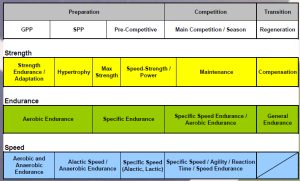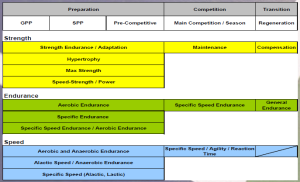APA Philosophy 3- Vertical Integration- it's all in the Blend
No philosophy would be complete without some sort of position on planning. I use this term rather than Periodisation as this immediately associates itself with complex terminology and Eastern European practices not relevant to most trainers needs. Trust me I have read these documents and they can take you too far away from the basic concepts you really need to be familiar with.
I have to admit, it took me a LONG time to get my head around this one so I hope it turns on a few light bulbs and new coaches don’t have to go through the same process as I did. Basically I went to University in the day when Tudor Bompa was the messiah and Linear Periodisation was the main form of periodisation taught.
I am not going to get into the theory of Training Adaptation as there are a number of voluminous textbooks out there to help but visit the Philosophy page for more detail:
As a quick summary, The Science and Practice of Strength Training (Zatsiorsky and Kraemer) states that Overload, Accommodation, Specificity and Individualization are the basic concepts of physical training. To obtain your short and long term goals you must follow these basic principles of programme design.
For the purpose of this blog I will not go into great detail about the different models of periodisation used to achieve these adaptations. There are many different ways to plan a programme. In short, there are two major schemes, Concurrent and Sequential (or Linear).
Below is an example of a classic linear periodisation model:
So in the case of strength for example, Strength endurance > Anatomical Adaptation > Hypertrophy > Max Strength> Speed-Strength might represent 5 mesocyles for sake of argument. Here you would do no power work (speed-strength) until after several phases of progressive strength development. Yes you could argue that you need a strength platform to benefit from power training but I could argue equally strongly that you need the technique of how to clean first so when you do ‘Focus’ on power you actually have the techniques to get the benefit of the exercise!! This linear periodisation approach is represented diagrammatically as horizontal integration.
In fact when I was first taught to develop Biomotor Abilities in a linear manner I was taught that the focus needed to change something like this:
Endurance >> Strength >> Speed
On one level this is still what I do (in a fashion) but I was taught a very literal interpretation of this where you ONLY do endurance for a period of time, or at least it was the case that you did say 5-6 sessions of it and say only 1-2 strength sessions and NO speed work. My first experience that led me to question this approach was when I started working with someone who to this day is a colleague of mine, Sergio Cuesta Gomez. He is the physiotherapist/ tennis coach at the Tennis Academy where I spend most of my time. When I told him that I was only going to do 1-2 strength sessions with a tennis player we were working with at the beginning of a training block he nearly chocked on his food!
He showed me a new way of thinking where every week you’re going to do at least 15-20 units of training but the distribution of training will be fairly evenly spread across all the different biomotor abilities. This type of periodisation is known as concurrent periodisation. It is just the Training Load (Intensity versus Volume) that is manipulated to create a focus for a certain type of training. This is represented diagrammatically as Vertical Integration.
Now it looks more like this where in this example strength is the main focus but we are still working on all the other biomotors:
Suppleness
Skill
Strength
Speed
Stamina
Now, the clever bit is knowing where the athlete is on their athletic journey based on their stage of development, assessment results and the current Goals they are aiming to achieve from a performance point of view. You use this to make decisions on which Biomotors you will spend more time teaching, which ones will be trained and which ones will be sustained!!!! The diagram below shows how this might look diagrammatically:
APA athletes train Concurrently.
This means my athletes train vertically across several different biomotor abilities during the same session, week and month!
Below is perhaps the most succinct explanation of the principle of concurrent periodisation I have ever seen written as it relates to the concurrent development of strength and power. It is written by Dr Lon Kilgore, PhD based on experiences from his time at the USA Weightlifting Regional Development Center
Beginners should do LOTS of the competitive lifts with moderate weights. To us, moderate means as heavy as can be done with consistently good technique and a low percentage of misses, whether it is 75% or 95% of max. Most workouts are started with snatch and clean and jerk, and in most workouts beginners do at least 20 snatches and 10 clean and jerks. We aren’t afraid to try new maxes whenever they seem possible, but try to do it within a framework of lots of lifts, few ugly lifts, and fewer misses.
We believe in doing all 3 squat variations normally done by weightlifters (front squat, back squat, and overhead squat), most weeks doing at least one workout of each style. We focus on the back squat for strength building, and concentrate on good position in front squatting and overhead squatting. We also do ‘unusual’ strength exercises, exercises designed not only to strengthen, but to condition and toughen. Exercises like dumbbell and barbell clean and press (each rep includes a clean and a press), walking lunges, kettlebell work, and strongman type training. We believe the training of beginners is a three-fold process, learning efficient technique on the competitive lifts, increasing strength, and conditioning the body to handle the increased training that will be required as a more advanced lifter.
Our training programs for beginners are simple. A sample weekly workout for a first year, 12-13 year old lifter could look like this:
Monday
>20 snatches
>10 clean and jerks
> 3 sets of 3 front squats
> 2 sets of 10 dumbbell clean & press
Wednesday
> Snatch to roughly 95%
> Clean and jerk to roughly 95%
> 5 sets of 5 squats
> Walking lunges, 2 sets of 40 yards each
Friday
> 20 hang snatches
> 20 hang clean and jerk (could alternate jerk and power jerk)
> 3 sets of 5 overhead squat
> 3 sets of 10 bent press with kettlebell
We try to end each workout with some low-back and abdominal work, and some jumping exercises. For this we use a glute-ham bench, a reverse hypermachine, lots of bands and medicine balls, and Plyo Boxes.
We don’t believe in a lot of ‘formal’ periodization for beginners. The strength, technique, conditioning, and abilities of beginners are changing at a rate that makes planning difficult. We have found the best way to periodize a beginner is to simply shift focus over time from one part of training to the next (This holds true for intermediate and advanced lifters).
Immediately after one competition and looking forward to another in say, 3 months, one of our lifters may spend the first month focusing on conditioning exercises (aka accessory exercises). The snatches and clean and jerks and squats will still be done, but the majority of the energy of the workout might go to the walking lunges, the kettlebell exercises, the clean and presses, and the various glute-ham raises, reverse hyperextensions, and ab work that ends the workout.
The next 4-6 weeks may be spent with the emphasis on squatting. Like the previous month, the workouts still start with snatches and clean and jerks, and heavy weights are lifted in these exercises when possible, but the emphasis of the workouts is pushing the different squat variations to new maxes. Workouts end with lowered volumes and intensities of general strength work like clean and press, and lowered volumes of lower back and ab work.
The last 2-4 weeks before a meet, the emphasis shifts to the competitive lifts. Squatting and other strength work is decreased, so that the lifter comes into each workout fresh and ready to do their absolute best on the competitive lifts.
It is important to note that the workouts throughout this time would look pretty much the same on paper. The sample workout shown above could show a week 3 months prior to competition, or a week’s workouts only 2 weeks out.
We don’t stop doing any strength exercises before a competition, and we don’t stop doing the competitive lifts in the ‘off season’. we just shift where we really ‘push’ and focus our energy.
So there it is. A simple program that pushes the kids continuously, is simple to understand and follow, and not only builds the total, but prepares the body for more frequent, more intense later training.


